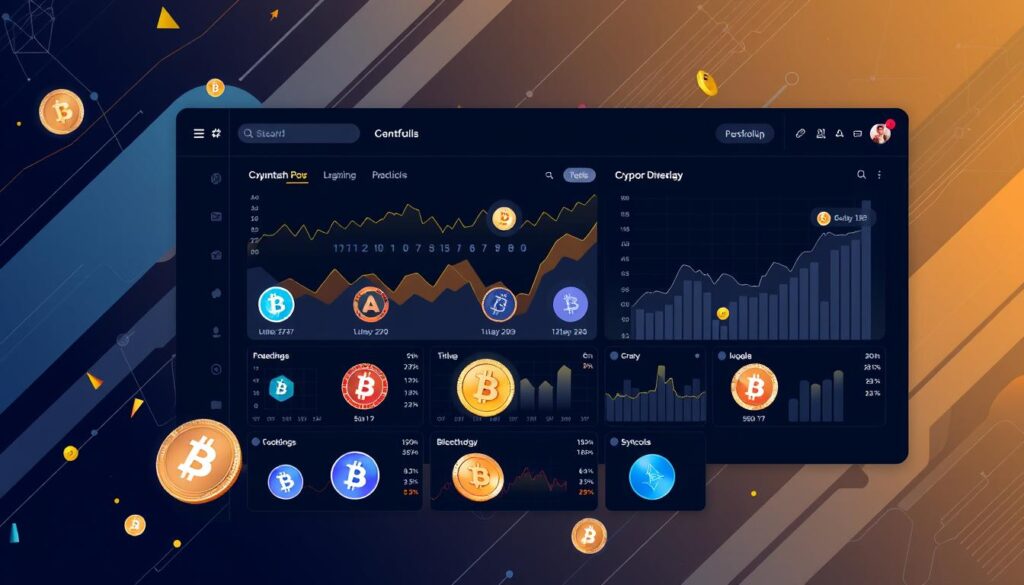In today’s fast-changing world of finance, cryptocurrency and digital assets are getting a lot of attention. Whether you’re an experienced investor or just starting out, it’s important to understand the basics. This guide will help you grasp the basics of cryptocurrency and blockchain, making it easier to explore the world of digital assets.

Cryptocurrencies like Bitcoin and Ethereum are changing how we see money and finance. They offer a new way of doing things, with more control and transparency for users. The technology behind them, blockchain, is also groundbreaking. It makes it possible to keep records securely and transparently for many uses.
Key Takeaways
- Cryptocurrency is a digital form of money that operates on a decentralized network, independent of traditional financial institutions.
- Blockchain technology is the foundation of cryptocurrencies, providing a secure and transparent ledger for recording digital transactions.
- Understanding the different types of digital currencies, their unique features, and the mechanics of crypto transactions is crucial for beginners.
- The world of cryptocurrency and digital assets offers both opportunities and risks, making it essential to approach this field with caution and a thirst for knowledge.
- Familiarizing yourself with the basics of cryptocurrency and blockchain will empower you to make informed decisions and capitalize on the potential of this transformative technology.
Understanding the Basics of Cryptocurrency and Blockchain
In the world of digital finance, cryptocurrency and blockchain are key terms. Knowing these basics is important for anyone interested in digital assets.
What is Blockchain Technology?
Blockchain is a digital ledger that records transactions on many computers. It’s a system without a central authority. Each block in the chain holds many transactions.
When a new transaction happens, it’s added to every computer’s ledger. This makes blockchain secure and transparent. It’s hard to change, keeping records safe.
Types of Digital Currencies
- Bitcoin – Introduced in 2009, Bitcoin is the most known digital currency.
- Ethereum – Ethereum is a platform for apps and has its own cryptocurrency, Ether.
- Other popular ones include Litecoin, Ripple, and Dogecoin, each with special features.
How Crypto Transactions Work
Crypto transactions use digital wallets for sending, receiving, and storing assets. These actions are recorded on the blockchain, ensuring safety and transparency. Crypto mining adds new transactions to the blockchain, with miners getting some cryptocurrency as reward.
| Cryptocurrency | Market Capitalization (as of May 2023) | Transactions per Second |
|---|---|---|
| Bitcoin | $1.1 trillion | 7 |
| Ethereum | $230 billion | 15 |
| Litecoin | $12 billion | 56 |
Learning about cryptocurrency and blockchain is the first step into digital assets. As these ideas grow, staying updated is key for the future of finance.
“The blockchain is an incorruptible digital ledger of economic transactions that can be programmed to record not just financial transactions but virtually everything of value.”
– Don Tapscott, author and blockchain expert
Crypto Made Simple, Guide to Digital Assets
Exploring digital asset investments can feel overwhelming. But this guide aims to make it easier for beginners. We’ll cover how to create a crypto portfolio and understand non-fungible tokens (NFTs) and decentralized finance (DeFi).
Diversification is key in digital asset investments. Spreading your money across different cryptocurrencies can lower risks and boost returns. We’ll show you how to build a balanced crypto portfolio that fits your goals and comfort level.
The world of NFTs has drawn many investors. These unique digital assets open up new ways to own and invest. We’ll explain what NFTs are, their uses, and how to include them in your digital asset investments.
DeFi is another exciting part of the crypto world. It offers services like lending, borrowing, trading, and earning yield. We’ll give you an introduction to DeFi and how to explore it in your digital asset investments.
We’ll also help you find your way around crypto exchanges. These platforms let you buy, sell, and trade digital assets. We’ll talk about what to look for when choosing the right exchange for you.
By the end of this guide, you’ll know a lot about digital asset investments. You’ll understand how to build a diverse crypto portfolio that matches your financial goals. Let’s start making crypto easy!

“Investing in digital assets is not just about chasing the latest trends; it’s about building a sustainable and diversified financial future.”
Conclusion
The world of crypto and digital assets is changing fast. It offers both great chances and big risks. The technology behind it, blockchain, has huge potential. It’s used in many areas, from finance to supply chains.
In the crypto future, we’ll see more people and companies using digital assets. This is because they like the ease and openness of online deals. The use of blockchain applications will grow, changing how we handle money and more.
But, we must not forget the risks of crypto. This market is unpredictable and not well-regulated. Investors should be careful, do their homework, and only risk what they can lose. By knowing the basics and staying up-to-date, people can safely enjoy the growth of this new tech.
FAQ
What is Blockchain Technology?
Blockchain is a digital ledger that records transactions on many computers. It’s the tech behind cryptocurrencies like Bitcoin, making them secure and transparent.
What are the Different Types of Digital Currencies?
There are many digital currencies, like Bitcoin and Ethereum. You also have stablecoins, altcoins, and memecoins. Each has its own features and uses.
How Do Crypto Transactions Work?
Crypto transactions move digital assets from one wallet to another. The blockchain network helps, using cryptography and miner validation.
What is a Digital Wallet?
A digital wallet stores your cryptocurrency securely. It lets you send, receive, and manage your digital assets. There are software, hardware, and mobile wallets available.
What is Crypto Mining?
Crypto mining verifies and adds transactions to the blockchain. Miners use computers to solve math problems. They get new cryptocurrency tokens as a reward.
How Can I Build a Diversified Crypto Portfolio?
To diversify your crypto portfolio, invest in different digital assets. This includes Bitcoin, Ethereum, and altcoins. Research each asset’s risk and potential return before investing.
What are NFTs (Non-Fungible Tokens)?
NFTs are unique digital assets on the blockchain. They can be art, collectibles, or virtual real estate. NFTs prove ownership and scarcity of digital items.
What is DeFi (Decentralized Finance)?
DeFi is a blockchain-based ecosystem for finance. It offers decentralized solutions for lending, borrowing, trading, and earning interest on digital assets.
How Can I Buy Cryptocurrencies?
You can buy cryptocurrencies on exchanges like Coinbase, Binance, or Kraken. These platforms let you trade digital assets with fiat or other cryptocurrencies.


